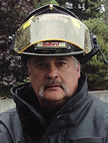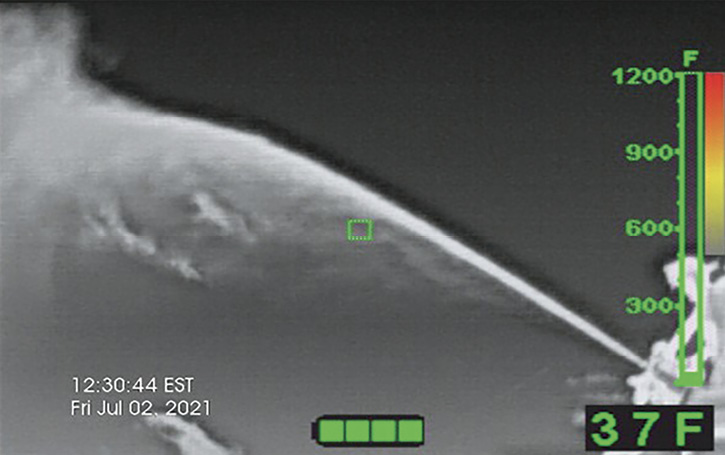
Thermal Imaging Manfred Kihn
The use of thermal imaging in the fire service continues to evolve as firefighters look to expand the technology to every aspect of firefighting.

We know how valuable the technology is for interior fire operations and direct fire suppression activities, but how can we apply this tool to help firefighters with aerial attack applications? A thermal imager (TI) can be extremely helpful to firefighters on the ladder crew. This group of firefighters is responsible for placing the apparatus in the right spot, opening vent holes, and positioning the master stream. The decisions made by the ladder crew are critical to attacking the fire aerially and on the ground.
Best Positioning of Apparatus in Multiple Scenarios
Placing the apparatus for attacking the fire from above depends on many factors, including the type of structure, building construction, obstructions overhead and on the ground, the size of the area needing to be contained, and access points. Knowing the best place to position the ladder truck is a critical one as this impacts hazards, scene coordination, and overall effectiveness. The greatest concern with apparatus placement is the presence and location of overhead electrical lines. Inadvertent contact with electrical lines can have catastrophic consequences for anyone on or touching the apparatus. During a nighttime fire, power lines can be difficult to see. Add inclement weather, and it can be even harder to determine where these lines are. This is where your TI is a valuable tool; it can help the truck operator determine the best placement of the apparatus to help with search and rescue, extrication, ventilation, and overhaul.
- A Closer Look at Thermal Imaging for Firefighters
- Thermal Imaging Safety Training
- Thermal Imaging: Thermal Imaging Use in Fire Prevention
- Thermal Imaging: Think Strategic Deployment During Fire Attack
- Thermal Imaging: Understanding Your TI Technology
- Thermal Imaging: Look How Far We Have Come
- Thermal Imaging: Thermal Imagers Are Not Without Risks
- Thermal Imaging: How to Prevent the “White Hat Syndrome”
- Thermal Imaging: Thermal Imagers Not Just for the Crews
- Thermal Imaging: Industrial and Environmental Fire Situations Need a Thermal Imager

1 Energized power lines. (Photos courtesy of Bullard.)
Identifying Various Hazards
Aerial ladders are often used during high-rise fires. Add smoke and darkness to this scene with zero visibility, and it is nearly impossible to see the structure’s upper windows and roof line for hidden dangers. Your TI can help identify electrical lines because electricity generates heat as it travels through the line, and the TI can identify heat, making the power lines easy to locate. Now, scan the scene using your TI to help locate problems such as electrical service wires, window-mounted air-conditioners, and a host of other hazards you need to avoid. The TI can also help detect people who are at the windows but obscured by smoke. Never use your TI to determine whether down lines are energized—just whether they are present.
Ventilation Tasks
You can use your TI to perform a variety of ventilation tasks—for example, to identify the warmest area of the roof. If you are in the bucket, be sure to scan the roof with the TI from your elevated position to identify the area of the roof where the heat is collecting or the warmest part of the roof. Now that you have scanned the roof area, you know where to start making your cuts. Remember, during the day, warm spots can easily be mistaken for higher temperatures under the roofing material.

2 Monitoring a deck gun flowing water.
Use your TI to scan the overall structure to monitor the effectiveness of vent operations. If you notice that one area of the roof is warmer than another and that location is supported by visible fire conditions, you may be able to move the ventilation hole to a more appropriate spot. Your TI can help you identify the most effective place for your ventilation hole.
Precision Aim and Effectiveness
Elevated master streams are used to send water down from above a fire in an upper floor. But how often have you seen the gallons of water streaming from a ladder pipe shooting over the top of the building, never hitting the fire? Use a TI for a more precise aim at the fire and a much better chance of suppressing it quickly and safely.
Heavy smoke conditions and darkness in general can impede the ability of the crew to place the stream where it is effective. Using a TI lets you direct the stream to its intended target. You can use the TI to place the stream with pinpoint accuracy and get the water exactly where it needs to go, with no more guessing involved. Operations will be quicker and more efficient while using less water. Be sure the TI is properly secured to the firefighter in a way that would not impede his movements while fighting the fire.
High Deployment of TI = Efficiency
Ideally, when fighting a structure fire that involves more than one ladder company, a TI is equipped on each apparatus. Ladder companies often split up on the fireground to simultaneously work together to fight the fire; having an apparatus without a TI is impacting the safety and efficiency of all the responding crews. Having multiple TIs on the apparatus lets the crews operate at a much higher efficiency level than if they only had one TI available.
A TI has many uses—not just for interior fire suppression. It is a valuable tool to firefighting crews on ladder companies, who benefit from the technology in a variety of situations. Ladder crews can perform their jobs safer, faster, and more efficiently with a TI.
Manfred Kihn is a 19-year veteran of the fire service, having served as an ambulance officer, emergency services specialist, firefighter, captain, and fire chief. He has been a member of Bullard’s Emergency Responder team since 2005 and is the company’s fire training specialist for thermal imaging technology. He is certified through the Law Enforcement Thermographers’ Association (LETA) as a thermal imaging instructor and is a recipient of the Ontario Medal for Firefighters Bravery. If you have questions about thermal imaging, you can e-mail him at manfred_kihn@bullard.com.

